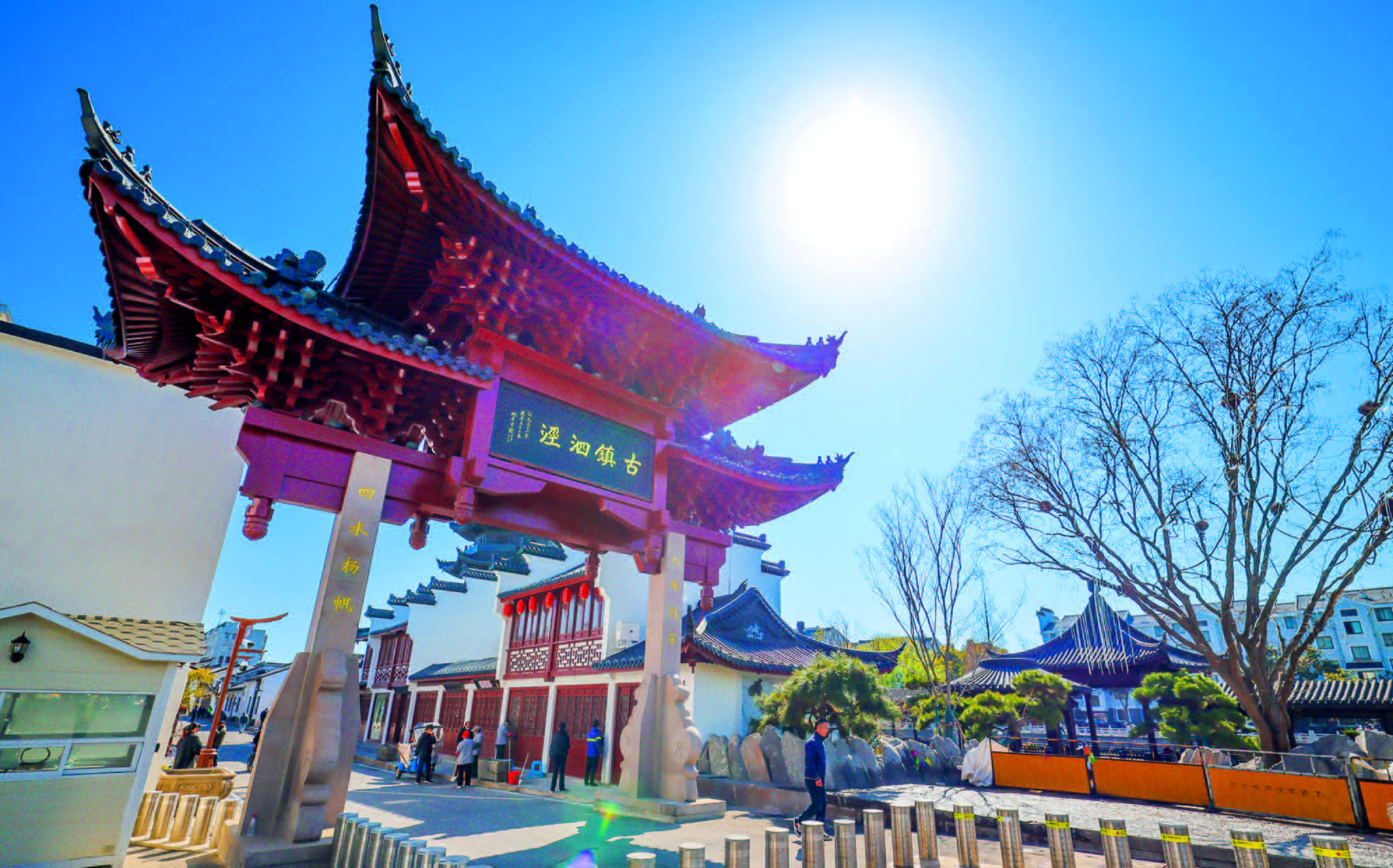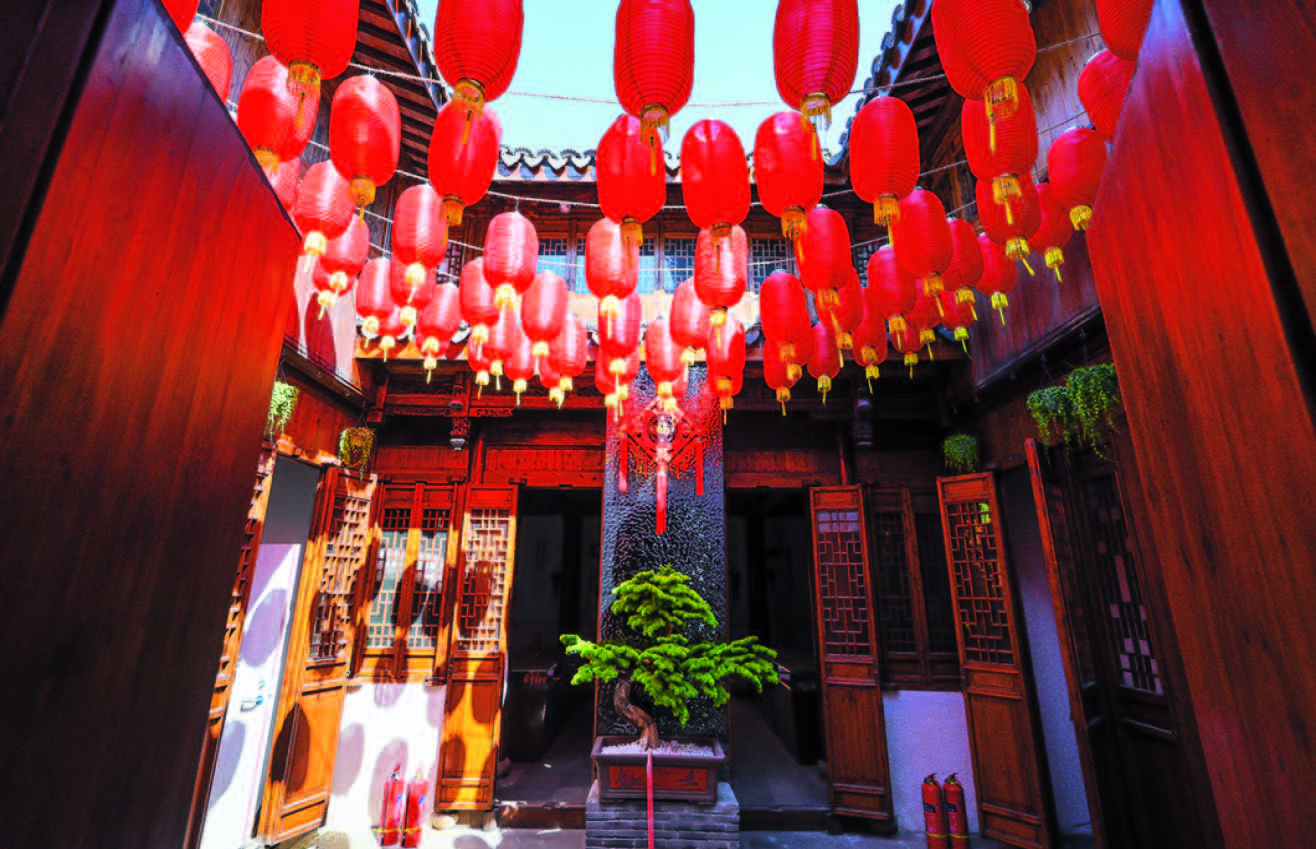

Sijing Ancient Town reopens after five years of renovation

The entrance archway of Sijing Ancient Town — Ti Gong

The Baolun Hall — Wang Jibo

The old house of the Shi family — Ti Gong

Sijing Ancient Town gets a new look. — Ti Gong

The former residence of Ma Xiangbo — Ti Gong
Tan Weiyun
Sijing Ancient Town is opening to the public after a five-year renovation project, giving a facelift to the old watertown’s ancient houses.
Dating back to the Song Dynasty (AD 960-1279), Sijing was named for its meeting point of four (si) major riv-ers (jing) and many canals, streams and ponds.
The centuries-old town, in a classic layout of a typical watertown on the southern bank of the Yangtze River, is abundant with stone bridges.
A stroll along the old Kaijiang Road takes people back to the days of yore with the wooden and brick-laid houses still as true as they were almost a cen-tury ago.
Most of the town’s old houses are around 90 years old. Technically speak-ing, only the architecture built before 1920 can be certified as a “relic house” which is eligible for national protection and preservation. Sijing currently has 54 relic houses, that is to say, the rest of the town’s old buildings haven’t met the national protection standard.
“But experts who visit the town have all agreed that they are still valuable and worth careful, systemic renovation,” said Wang Jibo from the town’s Protection and Renewal Management Committee.
The renovation project has been run-ning for almost five years, and strict preservation regulations have been ap-plied according to traditional Chinese architecture methods.
Every original old brick from the houses has been numbered for correct replacement and if they were too bro-ken to be used again, the construction team traveled around China to find traditional kilns that still produce handmade bricks.
Old wooden beams and pillars have been repaired, strengthened and re-painted by experienced carpenters, and old tiles have been cleaned, fixed and re-carved.
The renovation team discovered a stone-carved floor tile with a round disk pattern in the center, engraved with a flower vase, bronze coin, silver ingot and ruyi (S-shaped ornamen-tal object) at the four corners, which means good fortune and luck in an-cient Chinese culture.
“In our practice in the old architecture renovation, carved bricks and wooden pieces are a common sight, but stone carvings are rare,” Wang said. “It might give us some clues in the study of Si-jing’s rich family residences.”
In future, the tiles will be protect-ed with glass covers for visitors to take a close look.
The Yang Tiansheng’s Old House, built during the Republic of China period (1912-1949), reveals some inter-esting information and folk traditions of the time. After an aluminum alloy partition on the second floor was dis-mantled, a hidden wooden door came to light. The cultural relic repair expert Xi Jianzhong immediately noticed it was different.
“The door was very thin, but it didn’t bend at all after so many years, show-ing its exquisite craftsmanship,” Xi said.
Upon entering the room behind the door, he also discovered a small hole in a wall, with a moving brick inside.
“It worked as a ‘lookout tower,’ through which people in the room could secretly observe the situation on the back street,” he said. “It indi-cates that public security was perhaps not so good at the time.”

Sophisticated decorations on a pillar of a local old house — Ti Gong
It was the second “lookout tower” the expert has seen. The first one was in the Confucius Temple in Jiading District.
Former home of Shi Liangcai
One of the historical sites in the town that has undergone repair and been made accessible to the public is the for-mer home of Shi Liangcai (1880-1934), a newspaper magnate in the early 20th century.
Shi, a native of Nanjing, Jiangsu Prov-ince, owned the Shun Pao (Shanghai News), the most popular Chinese news-paper in Shanghai, and he was slain by a Kuomintang secret agent in 1934.
His home, which was initially con-structed in 1916, has served as the district’s administration, a cultural hub and a library since 1949. For bet-ter protection, it was classified as a historic site in 2000.
The compound has three traditional Chinese courtyards and a brick-and-wood villa, an ideal fusion of Eastern and Western architectural forms.
The old-fashioned yimen, literally “the door of etiquette,” which serves as the secondary entrance to a Chi-nese home, is inlaid with bricks that have been brilliantly inscribed, and the wooden pillars and beams have also been carved with legends and historical accounts.

A view from the “lookout tower” of Yang Tiansheng’s Old House — Tang Feng
The third courtyard features West-ern architectural elements such as the cement ornaments on the roof and the iron railings on the second floor.
The home underwent its most recent phase of renovations in 2020, which included the memorial archway at the main entrance, the front wall (a screen used in Chinese residential buildings to keep private life hidden from view), the three courtyards and the two gardens.
The wooden structures — the doors, windows, knobs and posts — had to maintain their original appearances. The hand removal of old paint to pre-serve as much of the natural color and texture of the wood surface as possible was one of the most challenging aspects of renovating a wooden structure.
The rotting bases of wooden columns were replaced with new ones using tra-ditional techniques.
Another substantial work involved repairing the wall. The first step in renovation is to evaluate the existing materials and select the best ones.
Traditional Chinese architectures frequently used paper strips mixed with lime mortar on the wall surfaces, which has strong air permeability but is also prone to hollowing issues.
The hydraulic lime material with strong permeability and stiffness was ultimately chosen after several water content tests. It’s an effective alterna-tive to cement mortar and a reversible restoration techniques. To preserve the original architectural design, the standard proportion of paper strips mixed with lime mortar was also incorporated.
Over the course of a century, wind and rain have partially corroded the two stone lions that are perched above the roof crest. To delay the rate of weathering during the repair, they were lightly rubbed with water repellent.
Old residence of Ma Xiangbo
A few steps away is the former resi-dence of Ma Xiangbo (1840-1939), an esteemed educator, visionary and patriot. His house has been opened free to the public after rounds of renovations.
The house, built in the 1700s, has five halls and four gardens, covering an area of 850 square meters. Prior to being renovated, the house was used as a warehouse, village activity center and highly partitioned residence. Today, the old architecture, which showcases rich collections of Ma’s photos, callig-raphy, letters and daily items, tells the story of great man’s life, full of twists and turns.
Ma is revered as a progressive edu-cator and founder of the prestigious Fudan University. His illustrious stu-dents included Cai Yuanpei, who later became head of Peking University, and Yu Youren, a high-ranking official in the Republic of China.
Ma was a child prodigy. He started studying astronomy at the age of 5, and was studying French, Latin, Greek, math, physics and philosophy by the age of 12.
He is remembered as a man of great compassion and patriotism. In 1876, he collected 2,000 silver ingots to help victims of a famine.
The young Ma studied in Japan, the United States, France and Italy. He was greatly influenced by Western culture and ideas, and developed the convic-tion that only education could save China.
In 1900, he returned to China and devoted 200 hectares of Songjiang farmland he inherited from his fam-ily as the site for what would become Fudan University. His one-time resi-dence in Sijing, Songjiang, is located at the end of a lane off Kaijiang Road M.
Visitors to the restored home can see numerous exhibits, documents, photo-graphs and the books he once read in his early years, tracing Ma’s life and accomplishments.
The fourth hall revives his study called “Leshan Hall,” a barely furnished room with a simple desk and full book-shelf. In the garden, Ma’s sitting statue is situated in the center, with rockeries as the backdrop.
Some of the old houses in the town have been transformed into book-stores, coffee shops, tearooms, craft studios, a guqin (ancient Chinese stringed musical instrument) show-room and a comics gallery, and are now open for business.
江苏路特数字科技有限公司 仅提供技术服务支持,文字、图片、视频版权归属发布媒体

